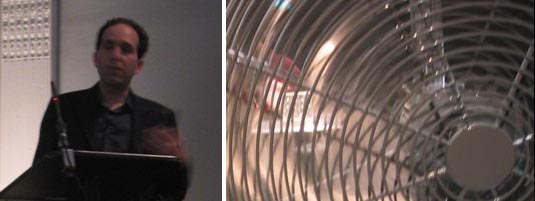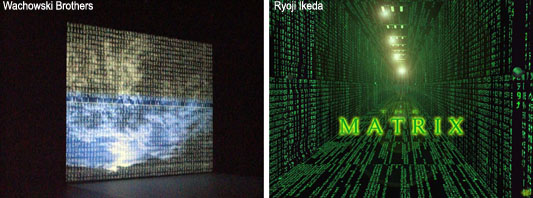

 subscribe
subscribe
Scott Snibbe's exhibition Body, Space and Cinema, at the ICA is a retrospective of his work which spans nearly 10 years.
What I found interesting about Scott Snibbe is the user-friendliness of his work, which can be appreciated on many different levels. On the one hand you have its simplicity, inviting child-like play; on the other hand you have its philosophical and phenomenological roots which gives his work more depth. Ultimately, this means his work is accessible to all. As he later confirms, the most important thing for him is in engaging as many people as possible.
How quickly a whole zeitgeist, idea of lifestyle and trend can change becomes obvious, if you look at the following clip taken in October 2001.
Steve Jobs of Apple Corporation reveals the iPod. At that time, the iPod was not more than a fantastic vision. Today, it's ubiquitous reality.

The announcement by house/band hybrid Planet Funk that they will be distributing their latest single (out next month) via mobile phone is another landmark in new media history.
After Gnarles Barclay's already annoying track reached "number 1" a couple of weeks ago through downloads alone, we are continuing to see new practises in terms of media distribution.
The Take Away Festival in the Node London context once more showed up, how closely software development, media and arts are connected to each other.
For many people, at the first glance, there may not seem to be an intermediate connection between those industries - particularly not between software development and arts.

Ryoji Ikeda's 'performance/installation' hybrid, shown at the Barbican on Monday night, was comprised of 2 parts, mainly exploiting sound's physical property, and its causality with human perception.
The first part of the performance was "formula [prototype-ver.2.3]", a work in progress that Ryoji first performed at Queen Elizabeth's Hall in 2000. So over the past 6 years the project has apparently been constantly evolving.
MAzine puts media arts centre stage
Please discuss all aspects of the node.london 2006 season of media arts here. You just need to register first. If you want to start a new forum topic click 'create content' and away you go.
 |
||
 |
> - - - - - - - - < |
 |
A collaborative text written by Marc Garrett and Ruth Catlow, for "Media Mutandis: A Node.London Reader" (to be published in February 2006)
There is a Sufi fable in which a group of foreigners sit at breakfast, excitedly discussing their previous night’s exploration. One starts saying “…and what about that great beast we came across in the darkest part of the Jungle? It was like a massive, rough wall.†The others look perplexed. “No it wasn’t!†says one, “It was some kind of pythonâ€. “Yeah…†another half-agrees, “…but it also had powerful wingsâ€. The shortest of the group looks bemused- “well it felt like a tree trunk to me.â€
This fable aptly illustrates many aspects of the NODE.London experience. The name, which stands for Networked Open Distributed Events in London [1], indicates the open, lateral structure adopted to develop a season of media arts. It is intentionally extensible, suggesting possible future NODE(s).Rio, .Moscow, .Mumbai etc. As participants/instigators in the project’s ongoing conceptualization and praxis, we are just two individuals positioned on the interlaced, scale-free networks of NODE.L (more on these later). As such, our descriptions of this collectively authored project are inevitably incomplete and contestable, with a complete picture emerging only in negotiation with others.
At time of writing we are between the two key milestone events of NODE.L: October’s ‘Open Season’ of conferences (with its focus on media activism) and the Season of Media Arts, planned for March 2006 (which will feature distributed media arts projects, exhibitions and events). Through these events NODE.L offers a rare chance to identify shared purposes, philosophies, resources (such as licenses and tools for knowledge sharing) and common vocabularies between the media arts and tech-orientated, media activist communities.
What are network media environments? Here at Ravensbourne College of Design and Communication, this is the kind of question we think about all the time. Even when we sleep. Sometimes our dreams now have Firefox border to it. But then again we are obsessives, especially Elkin. Anyway, we like to think that network media environments about people. So here is our inaugural 'Network Media Hall of Fame', made up of the most influential people in our emerging world.
Do you agree? This being a networked media environment. You can disagree. Is there anyone missing? Is there anyone we should delete? What other lists do you want to see? Do you dream in Firefox, too?